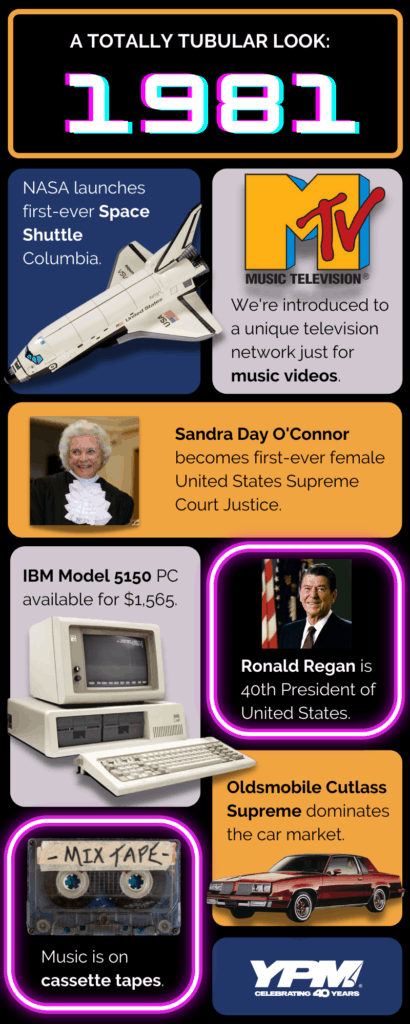Steve Lendino, long-standing President of YPM, was sitting in the large conference room in our Irvine, CA headquarters on a sunny July afternoon. His head was bowed, engrossed in something on his phone while he waited for this very interview to start. YPM’s Digital Team wanted to sit down with Lendino for an exclusive look back at the last 40 years (happy birthday to us!) and a look forward into the future of digital marketing. His head snapped up as soon as he saw us, his phone disappeared and it was game time, so to speak.
In the Beginning
Founded in 1981, YPM’s history is a page-turner — quite literally! If you take a look closely at YPM’s logo you’ll notice the M is turning a page. That’s because YPM used to stand for Yellow Pages Media. Forty years ago Instagram was still a twinkle in our eye, but Yellow Pages (YP) advertising was an industry that used to account for more than $16 billion in annual advertising sales.
Digital Team: While we’re on the subject of early YPM days, when did you first start working here and what did you do?
Steve Lendino: I started working at YPM part time when I was 18 as an office odds and ends helper, then full time at 22. It was a lot of errands, clerical and customer service work.
DT: You became President of YPM in 1997. What about the company made you want to make it your permanent home?
SL: I gravitated towards working with clients right away and really enjoyed the fact that every day was different from the last. The pace was of interest as well. From very early on, I was always impressed with the responsiveness and quality of service that was necessary to keep clients feeling appreciated. Remember there was no email or internet, it was sheerly phone call, customer service and building relationships. And we’re still in business today after 40 years because of the lasting relationships and initial cultural behaviors we created and built in the start up years.
As I said, I truly enjoy the pace or fluidity and ever changing marketing challenges when working with clients. No day is the same and challenges are never the same, either. Strategy and tactics are different from client to client, too.
DT: Clients are the backbone of YPM and we enjoy hosting them at our office. Where was the first YPM office located?
SL: We’ve always been in Orange County, CA. We started out in a small six-person office in Laguna Hills. It was so small you could see everyone at one time. It was chaotic, busy and we kept growing. We moved from there to Tustin, then we finally landed in the Irvine John Wayne Airport area, which is where we are today. Proximity to the airport is key since our brands are located nationally and internationally.
DT: Old YPM records show there were eight total employees when you first started, growing the business to 100+ employees by 2016. What was your favorite part about the growth?
SL: It was gradual and manageable growth, and it was exciting to see. After a number of tactical acquisitions, it was educational for me to experience the way our different talents melded together internally, spreading the wealth of their knowledge.
“I always say we hire subject matter experts, not just staff. Our staff is absolutely our best, most critical asset.”
DT: Having employees that think creatively is extremely important. Way before YPM started a YP media company, the pages themselves actually used to be white. Legend has it the printer ran out of white paper in 1883 and used yellow because the order for more white paper would’ve delayed the latest issue significantly. Later, studies began to emerge that black ink on yellow paper was easier to read than black on white!
While a printer in the 1880s isn’t exactly tech adverse, he was able to adapt to the demand for a change. Walk us through the kind of technology YPM relied on to run a successful advertising campaign.
SL: YP advertising was strictly print and the internet didn’t exist, so in order to measure our media’s success, we implemented unique tracking telephone lines to understand the KPIs and media success.
“We used Apple III and Compaq brand computers.”
We had up to ten creative artists in-house at one point, using all sorts of creative platforms such as Adobe PageMaker to generate print ads. We outsourced the layouts and we relied heavily on telephone communication for interacting with our clients.
Enter Internet
DT: The internet hit the advertising scene in the late 1990s and shook up a lot of strategies for brands around the world. Do you remember the moment when you knew the internet was going to change advertising, especially the YP business model?
SL: Yes! I specifically remember the inflection point. Mike Soenen, President and CEO of FTD at the time, called me up, requested an all-hands meeting with myself and the FTD executives at their headquarters in Downers Grove, IL. Mike said he wanted to cancel all $5 million of their annual YP campaign. He said all floral orders were eventually going to be online from then on. He was right and FTD is still a client today, 21 years later, doing a myriad of digital strategies with YPM, such as influencer marketing and floral lead gen.
DT: We always remember turning points both good and bad. Moving along on the timeline to 2001, it was a quiet Tuesday morning on September 11 and many were still commuting to work. News broke that two planes crashed into the World Trade Center in New York City. Nineteen Islamic extremists hijacked four airplanes and carried out suicide missions, flying them into the World Trade Center, the Pentagon in Washington, D.C. and crashing into a field in Pennsylvania. Almost 3,000 people died and it was the first time we saw such a dramatic shift in the way we do things in the U.S.
YPM was already pretty established at this point. How did this event affect the way you were running the agency?
SL: 9/11 changed how all companies interact, not just YPM. How our businesses communicate with each other, bond and transition together into the future became very important. People were afraid to fly for a period of time and the internet quickly became the consistent business tool and fundamental answer to that challenge and allowed us to connect with each other faster.
Economic Factors
DT: When the economy experiences strains like 9/11 and businesses still have to move forward, those are the times innovation creeps in. YPM also weathered the Recession in the late 2000s and is currently in the thick of the pandemic brought on by COVID-19. What are some of the lessons you’ve learned during these trying times.
SL: It’s about small bites and being excellent communicators. Chipping away and staying after the objective. The Recession was an extremely difficult, uncertain time where even banks were failing. YPM stayed true to our core standards as a business, didn’t waiver and we were lucky to never lay off even one single individual. The outcome of holding to our core values was that we emerged from that economic downturn with greater success when the Recession ended, leading up to record-breaking milestones in 2016.
With COVID, we’re doing the exact same thing, as best we possibly can. We’re not making drastic changes to our core business values and standards, we’re holding steady and we’re positioning ourselves to get crazy as soon as our clients and brands feel like they’re back to a stable media and business environment. We have been managing the business week to week and don’t look further out than the week we’re in because there are too many unknowns still.
“2020 taught us to stay supremely focused in shorter duration periods.”
DT: Naturalist Charles Darwin once said: “It is not the strongest of the species that survives, nor the most intelligent. It is the one that is most adaptable to change.” YPM started out in YP media and marketing but as digital avenues grew in popularity and importance, YPM pivoted to remain relevant and continue servicing our customers.
What would you advise clients that are looking to stand out and take a risk for change?
SL: My advice would be: first of all, you’re not the first brand that’s made a transition that YPM successfully helped manage and launch. Nothing should be a knee jerk reaction but it still takes courage to make a big change — and we can always learn together and modify the process as we get baseline data and understand the true return on your investment. I don’t advise brands to be conservative but instead I encourage proactive change and not to be reactive. Get ahead of the curve, be an early adopter to media tech, and trial, test and test again.
“Technology … precedes technique. We consult to help brands adjust their technique based on the latest media technology.”
DT: Speaking of proactive change, what was the barrier to entry like from YP to paid search?
SL: It was easier in the early days because people were more willing to listen, take risks and educate themselves. There were lower costs as well for keywords, given click inflation over the last 12 years or more. It was also a more adventurous time and often felt like the Wild West with no rules.
Forward Thinking
DT: A little birdy told us you used to play competitive hockey. Knowing athletes have to be in the right mindset when they train, what are some crossovers you’ve experienced in business?
SL: I sure did! It’s important to have mental toughness, preparation and focus in both hockey and business. Each morning I have a routine that gets me up to speed for the day: make coffee, check all early morning and late night emails, create a brief to-do list, then stretch out and get mentally ready for what’s ahead that day. Both planned or unplanned.
I used to play left wing, which is a strategic offensive position that focuses on getting the puck into the net — either by me or the other forwards. I had to be able to not only anticipate who had the best opportunity to score in a nanosecond but also have to determine if it would be me taking the shot. Because of my ability to see things from different angles at a fast pace, I now treat meetings like we’re hitting the ice. It makes me feel mentally prepped, on high awareness and to think on my feet swiftly.
“Muscle memory meets mental memory.”
DT: Let your fingers do the walking … Do you remember that? You’ve seen a lot of big companies land on the advertising scene since 1997. What surprises you?
SL: I do remember! The biggest surprise is that Facebook has been able to gain traction with their advertising audience in the face of Google. They were able to become Google’s competitor and figure out a successful digital game plan with a massive revenue stream.
DT: It will be interesting to follow Google, Facebook and others as we head into a post-pandemic landscape. On that note, what’s next for YPM?
SL: A few core items. First, work through and out of COVID together, with our brands at our hip. Broaden out further our internal bench strength and expertise in terms of staff and third, pursue acquisitions of digital agencies. I love growing YPM and want to see our clients or brands win. That for sure brings me the most reward. Their success!








